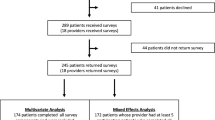Abstract
Research suggests that communication of mammogram results is flawed for many low-income ethnic minority women. This study conducted four focus groups with low-income inner-city minority women (n = 34). The goals of our project were: (1) to elucidate women's experiences learning of their result; (2) to elicit their preferences as to how this communication could be improved; and (3) to gather information to help inform the development of a new tool for communicating mammogram results. Salient themes included dissatisfaction with result communication; difficulty elucidating the meaning of a typical results notification letter; a preference for direct verbal communication of results and for print materials that included pictures, testimonials, and an action plan including a hotline to call with questions; and a strong interest in advance education about the likelihood of having to return for additional follow up. Video and other programs to inform patients before the test about what happens after may improve patient satisfaction and enhance women's understanding of their personal result and follow up plan.


Similar content being viewed by others
References
Burack RC, Simon MS, Stano M, George J, Coombs J (2000) Follow-up among women with an abnormal mammogram in an HMO: is it complete, timely and efficient? Am J Manag Care 6:1102–1113
Jones BA, Dailey A, Calvocoressi L et al (2005) Inadequate follow-up of abnormal screening mammograms: findings from the Race Differences in Screening Mammography Process study (United States). Cancer Causes Control 16:809–821
Chang SW, Kerlikowske K, Napoles-Springer A, Posner SF, Sickles EA, Perez-Stable EJ (1996) Racial differences in timeliness of follow-up after abnormal screening mammography. Cancer 78:1395–1402
Press R, Carrasquillo O, Sciacca R, Giardina E (2008) Racial/ethnic disparities in time to follow-up after an abnormal mammogram. J Womens Health 17:923–930
Adams SA, Smith ER, Hardin J, Prabhu-Das I, Fulton J, Hebert JR (2009) Racial differences in follow–up of abnormal mammography findings among economically disadvantaged women. Cancer 115:5788–5797
Poon EG, Haas JS, Puopolo A et al (2004) Communication factors in the follow-up of abnormal mammograms. J Gen Intern Med 19:316–323
Kerner JF, Yedidia M, Padgett D et al (2003) Realizing the promise of breast cancer screening: clinical follow-up after abnormal screening among Black women. Prev Med 37:92–101
Kaplan CP, Crane LA, Stewart S, Juarez-Reyes M (2004) Factors affecting follow-up among low-income women with breast abnormalities. J Womens Health 13:195–206
US Public Law 1998. 105–248:Mammography Quality Standard Reauthorization Act
Karliner LS, Kaplan CP, Juarbe T, Pasick R, Perez-Stable EJ (2005) Poor patient comprehension of abnormal mammography results. J Gen Intern Med 20:432–437
Jones BA, Reams K, Calvocoressi L, Dailey A, Kasl SV, Liston NM (2007) Adequacy of communicating results from screening mammograms to African-American and White women. Am J Public Health 97:531–538
Marcus EN, Sanders L, Pereyra M, DelToro Y, Romilly AP, Yepes M, Webb Hooper M, Jones BA (2011) Mammography result letters: are they easy to read and understand? J Womens Health 20:545–551
Chew LD, Bradley KA, Boyko EJ (2004) Brief questions to identify patients with inadequate health literacy. Fam Med 36:588–594
Miller WL, Crabtree BF (1994) Qualitative analysis: how to begin making sense. Fam Pract Res J 14:289–297
Levin K, Brauening PM, O'Malley M, Pisano E, Barrett E, Earp J (2000) Communicating results of diagnostic mammography: what do patients think? Academic Rad 7:1069–1076
Lown BA, Roy E, Gorman P, Sasson JP (2009) Women's and residents' experiences of communication in the diagnostic mammography suite. Patient Educ Couns 77:328–337
Raza S, Rosen MP, Chorny K, Mehta TS, Hulka CA, Baum JK (2001) Patient expectations and costs of immediate reporting of screening mammography: talk isn't cheap. Am J Roentgenol 177:579–583
Battaglia TA, Roloff K, Posner MA, Freund KM (2007) Improving follow–up to abnormal breast cancer screening in an urban population. Cancer 109:359–367
Baker DW (2006) The meaning and the measure of health literacy. J Gen Intern Med 21:878–883
Peerson A, Saunders M (2009) Health literacy revisited: what do we mean and why does it matter? Health Promot Int 24:285–296
Mojica CM, Bastani R, Ponce NA, Boscardin WJ (2007) Latinas with abnormal breast findings: patient predictors of timely diagnostic resolution. J Womens Health 16:1468–1477
Yabroff KR, Breen N, Vernon SW, Meissner HI, Freedman AN, Ballard-Barbash R (2004) What factors are associated with diagnostic follow-up after abnormal mammograms? Findings from a U.S. National Survey. Cancer Epidemiol Biomarkers Prev 13:723–732
Zapka J, Taplin SH, Price RA, Cranos C, Yabroff R (2010) Factors in quality care—the case of follow-up to abnormal cancer screening tests–problems in the steps and interfaces of care. J Natl Cancer Inst Monogr 40:58–71
Acknowledgments
The authors thank Marsha Stevens, Dorothy Parker, and Martha Gonzalez of the University of Miami Sylvester Comprehensive Cancer Center Disparities and Community Outreach Core for their indispensible help with this project. We also thank W. Jarrard Goodwin, Ada Patricia Romilly, Margaret Byrne, Gail Haldeman, and the staff of the Jackson Memorial Hospital/Taylor Breast Health Center for their support. Dr. Marcus receives salary support from the American Cancer Society (CCCDA 09-216-01) and the Ford Foundation (1095–0885). Dr. Dietz receives salary support from the James and Esther King Biomedical Research Foundation, the Flight Attendant Medical Research Institute, and the US Department of Defense.
Author information
Authors and Affiliations
Corresponding author
Rights and permissions
About this article
Cite this article
Marcus, E.N., Drummond, D. & Dietz, N. Urban Women’s Preferences for Learning of Their Mammogram Result: A Qualitative Study. J Canc Educ 27, 156–164 (2012). https://doi.org/10.1007/s13187-011-0284-1
Published:
Issue Date:
DOI: https://doi.org/10.1007/s13187-011-0284-1



